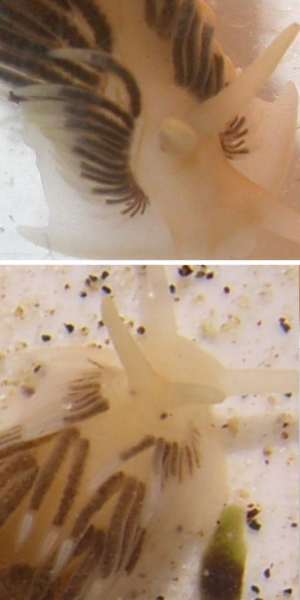Aeolidiella alderi from Bembridge, UK
September 29, 2005
From: Rebecca Cooksley


I regularly visit Bembridge rocky shore, Isle of Wight and often find sea slugs. Some have a very distinctive white ruff and so I have identified them as Aeolidiella alderi. I have also thought I found a couple of species which I initially believed to be Facelina bostoniensis, with dark cerata with white tips. However, the white tip on the first cluster of cerata sometimes extends beyond halfway down the individual cerata, only noticed on closer examination of the species. Could this species also be A.alderi? There has also been a considerable amount of variation in the colour of the cerata as well, from a dark grey to a dark yellow. The cerata do appear to extend beyond the length of the body in all those found. I know A.alderi has been found before at Bembridge, but I'm not sure if the white ruff on some of the specimens has been that distinctive and I know F.bostoniensis is often found in British waters. I attach a couple of photos of two different species, although they do not represent the variability in colour and intensity of colour.
Locality: Bembridge, Isle of Wight, UK. intertidal. Length: ~20 mm. September 2004, May/June 2005, September 2005. intertidal, limestone ledges, under boulders. Photographer: R.Cooksley, K.Marston
Many thanks for your help
P.S great website
Becky Cooksley
becky@medinavalleycentre.org.uk
Cooksley, R.C., 2005 (Sep 29) Aeolidiella alderi from Bembridge, UK. [Message in] Sea Slug Forum. Australian Museum, Sydney. Available from http://www.seaslugforum.net/find/14851
Dear Becky,
The almost complete lack of pigmentation on the skin, and the very large cnidosacs in the most anterior row of cerata are pretty good signs that both your animals are Aeolidiella alderi. Unfortunately the large cnidosacs are a bit difficult to see against the whitish foot. Have a look at Bernard Picton's discussion about Aeolidiella in UK [message #3845]. Species of Aeolidiella have the cerata arranged in many rows and their broad foot usually extends forward under the head, and in front of the cerata. In Facelina bostoniensis, the body shape is quite different, with the cerata arranged in large clumps and the head usually extending further forward than the foot. Also in that species, the rhinophores have 'annuli' or rings around them, while in Aeolidiella, they are smooth.
There is usually a range in colour in species of Aeolidiella, because they feed on variably coloured sea anemones, and the colour of the digestive gland ducts in each ceras is dependent on the colour of the food.
Best wishes,
Bill Rudman
Related messages
-
Aeolidiella alderi from Thau, French Mediterranean
From: Dominique Horst, November 28, 2007 -
Aeolidiella alderi from Croatia
From: Mat Vestjens, July 13, 2006 -
Aeolidiella alderi from UK
From: Judith Oakley, August 8, 2005 -
Aeolidiella alderi from sthn England
From: Judith Oakley, May 13, 2005 -
Guernsey opisthobranch
From: Richard Lord, November 20, 2003 -
Aeolidiella alderi - defensive behaviour
From: Marina Poddubetskaia, August 25, 2003 -
Aeolidiella alderi + eggs
From: Marina Poddubetskaia, August 10, 2003 -
Aeolidiella alderi from Tunisia
From: Anis, April 22, 2003 -
Aeolidiella alderi or A. glauca
From: Mauro Doneddu, January 21, 2003 -
Aeolidiella alderi from Strait of Gibraltar
From: Alma Sánchez, January 29, 2002 -
Re: Cuthona granosa ? from the Mediterranean
From: Bernard Picton , January 9, 2002 -
Cuthona granosa ? from the Mediterranean
From: Jean-Pierre Bielecki, December 19, 2001 -
Aeolidiella alderi
From: Jean-Pierre Bielecki, March 17, 2001 -
Aeolidiella alderi and parasite
From: Jean-Pierre Bielecki, February 20, 2001 -
Aeolidiella alderi or A. glauca
From: Bernard Picton , February 20, 2001
